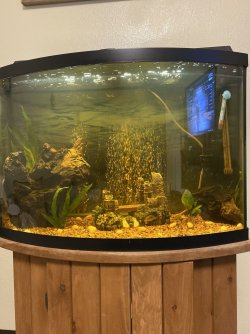Whenever ammonia is above zero when there are fish in the tank, you need to do a water change. This is the route to success with fish-in cycling, keeping the ammonia and later nitrite levels low enough that the fish are not harmed. yes, it will slow the cycle, but a slow cycle is preferable to harmed fish.
Ammonia exists in two forms in water - toxic ammonia and much less toxic ammonium. The amount in each form depends on the temperature and pH. At pH above 7, more is in the toxic form so water changes are even more important.
What type of ammonia remover did you get?
Those like zeolite remove ammonia. These starve the bacteria so they never grow in sufficient numbers. Zeolite gets full and stops working, so it has to be changed before it gets full or when it stops working the ammonia level will rise again.
Other types detoxify ammonia rather than remove it. The detoxification effect lasts around 24 hours, then it becomes toxic again. These should be used in conjunction with water changes - they keep the fish safe till the next day's water change.
Once the ammonia eating bacteria start to grow they produce nitrite. This is also toxic and there is no safe form of nitrite.
Your tap water probably has ammonia because your water provider uses chloramine to disinfect it. This is a chlorine and an ammonia joined together. Water conditioners split them up and remove the chlorine part, leaving the ammonia part in the water. Many water conditioners also contain something to detoxify this ammonia for 24 hours. In a cycled tank, the bacteria will remove this detoxified ammonia before it has chance to become toxic again.
What is the pH of your tap water, both freshly run and a glass of water that's been allowed to stand overnight?
How hard is your tap water? If you have hard water, that usually goes with high KH. This is a buffer which works to prevent the pH changing. Where KH is very high, bogwood tannins will have no effect on pH. Your water provider's website should have your hardness, and they may also give alkalinity - that's what water providers call KH.
The way forwards is water changes whenever ammonia is above zero. And when nitrite shows up, when ever that is above zero. If the ammonia remover is the zeolite type, stop using it as it will prevent the bacteria growing and it is a lot cheaper to let the bacteria do the work rather than replace the ammonia remover on a regular basis.
If you don't already have any, get some live plants. These also take up ammonia and they don't turn it into nitrite. Unlike ammonia removers, they don't need to be replaced if you give them what they need.
Feed the fish only once every two or even three days.
Get a good bacterial starter such as Tetra Safe Start or Dr Tim's One & Only.
Use Seachem Prime as a water conditioner. This detoxifies both ammonia and nitrite for 24 hours.
As a side issue, unless all three of the Bolivian rams were female, three is not a good number. Three males will fight for territory. 2 males, 1 female - the males will fight over territory and the lone female. With 1 male, 2 females, the male could well pair up with one female and the pair attack the other female.
I once bought two which turned out to be males. A few months later I found a shop with obvious females so I bought two. Then the males decided to kill each other so I removed one. Next the male and one female paired up and they tried to kill the other female so I had to remover her as well. The unwanted two went back to the second shop.


